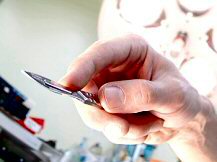

Home Page
The latest articles, features and news.


Read About...


Search Articles



Discussion Forums




|
| | |
|
30 March 2011
Minimally invasive breakthrough treats BPH
by George Atkinson  A new radiology treatment for benign prostatic hyperplasia (BPH - otherwise known as an enlarged prostate) shows comparable results to transurethral resection of the prostate, but with no risk of sexual dysfunction or urinary incontinence. The new minimally invasive treatment - known as prostatic artery embolization - was announced at the Society of Interventional Radiology's 36th Annual Scientific Meeting in Chicago.
A new radiology treatment for benign prostatic hyperplasia (BPH - otherwise known as an enlarged prostate) shows comparable results to transurethral resection of the prostate, but with no risk of sexual dysfunction or urinary incontinence. The new minimally invasive treatment - known as prostatic artery embolization - was announced at the Society of Interventional Radiology's 36th Annual Scientific Meeting in Chicago. "Benign prostatic hyperplasia or BPH is so common that it's been said that all men will have an enlarged prostate if they live long enough. I believe that a minimally invasive interventional radiology treatment will be the future treatment for benign prostatic hyperplasia or men's noncancerous enlarged prostates," boasted Jo�o Martins Pisco, chief radiologist at Hospital Pulido Valente, in Lisbon, Portugal. The new technique is heralded as a breakthrough because it shows comparable clinical results to transurethral resection of the prostate, but without the risks of surgery, such as sexual dysfunction, urinary incontinence, blood loss and retrograde ejaculation. Prostatic artery embolization is performed by a radiologist and a physician who is trained to perform this and other types of embolization. The radiologist makes a tiny nick in the skin in the groin and inserts a microcatheter into the femoral artery. Using real-time imaging, the physician guides the catheter through the artery and then releases tiny particles, the size of grains of sand, into the prostatic arteries that supply blood. These tiny particles block blood flow to the tumor, causing it to shrink. Following PAE treatment, most men experience no pain to light pain and leave the hospital four to eight hours after intervention. "There is no sexual dysfunction following prostatic artery embolization, and a quarter of our patients report that sexual function improved after the procedure," said Pisco.
Pisco said the best results were obtained on patients with prostates larger than 60 cubic centimeters and with very severe symptoms. "Pelvic arterial embolization may be the only feasible and effective treatment for benign prostatic hyperplasia in those men who cannot have surgery due to the size of their prostate [80 cubic centimeters] or because it is inadvisable for them to undergo general anesthesia." An estimated 19 million men in the United States have symptomatic BPH and statistics show that a small amount of prostate enlargement is present in many men over age 40. As many as 50 percent experience symptoms of an enlarged prostate by age 60 and more than 90 percent of men over the age of 85 will report symptoms. Related:
Sleep apnea may be behind prostate issues
Impotence drugs may help with prostate problems
Source: Society of Interventional Radiology
|
|





